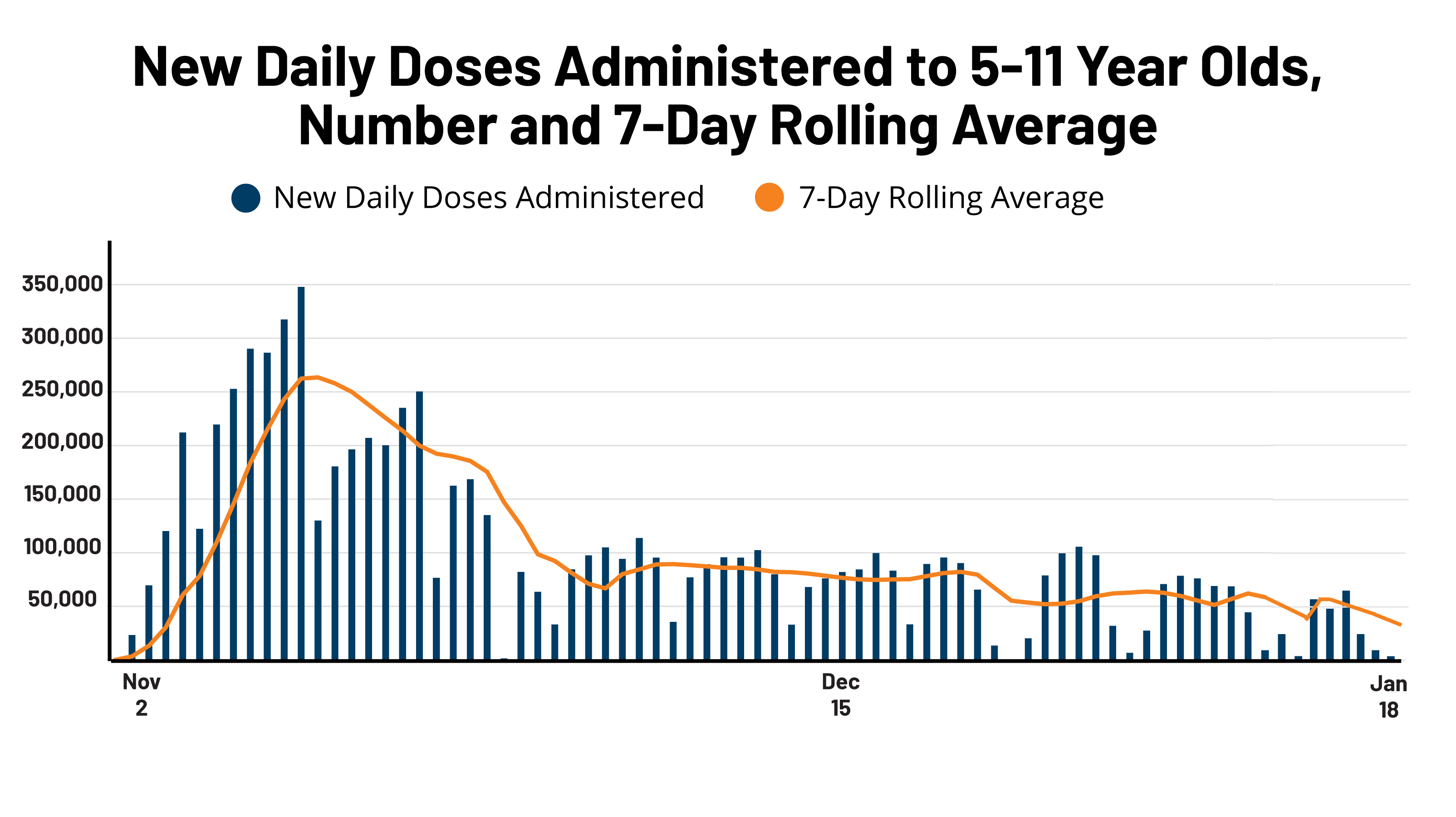It’s been more than two months since the Centers for Disease Control and Prevention (CDC) recommended Pfizer’s COVID-19 vaccine for children, ages 5-11, in the United States. We previously assessed pediatric vaccination uptake, finding that, after initial high demand, it had already slowed significantly. We also found a wide range in vaccination rates by state. Since that time, Omicron has become the dominant variant in the U.S. and COVID-19 cases, hospitalizations, and deaths are rising again.
Here, we provide an update on the vaccination status of 5-11 year-olds, through January 18, 2022. It is based on analysis of national and state-level vaccination data obtained from the CDC’s Data Tracker (see methods below). Overall, we find that the number of first doses newly administered to 5-11 year-olds remains far below its early peak and although there was a slight uptick for a period in December, it has again declined. There also remains a large gap – of 52 percentage points – between the most vaccinated and least vaccinated states. Specific findings include:
- Nationally, more than a quarter (28.1%) of 5-11 year-olds had received at least one COVID-19 vaccine dose as of January 18, 2022. This represents just over 8 million of the approximately 28 million children in this age group in the United States. Given the two dose Pfizer regimen, administered three weeks apart, and the need for a two-week period afterward to be considered to have completed the vaccine series, just 18.8% of children have reached this point.
- The rate of vaccination among 5-11 year-olds reached its peak before Thanksgiving and then dropped steeply. Vaccination rates among 5-11 year-olds, as measured by first doses administered daily, rose sharply for the two-week period after the recommendation was first made on November 2, hitting its high point on November 14, at 264,000 (based on the 7-day rolling average). It then dropped steeply through the beginning of December. After a slight uptick over the next two weeks, it dropped again and has hovered between 50,000 and 75,000 new doses administered per day, based on the 7-day rolling average, since the holiday period (Figures 1 and 2).
- Significant variation remains at the state level with a 52 percentage point difference between the top and bottom ranking states in the share of children with at least one dose. This difference is much larger than the span for adults (27 percentage points). The share of children having received at least one COVID-19 vaccine dose ranged from 63.1% in Vermont to just 11.2% in Mississippi (Table 1). The top ten states have vaccinated more than a third of 5-11 year-olds, with three states at more than 50%; the bottom ten states have vaccinated fewer than 20%. The spread between top and bottom ranking states for those fully vaccinated is 47 percentage points, and ranges from 52% in Vermont to 5.3% in Alabama.
- Some regional differences persist. Five of the top ten states, by share of 5-11 year-olds with at least one vaccine dose, are in New England (Vermont, Rhode Island, Massachusetts, Maine, and Connecticut). Eight of the ten states with the lowest vaccine coverage among 5-11 year-olds are in the South (South Carolina, Georgia, West Virginia, Oklahoma, Tennessee, Louisiana, Alabama, and Mississippi). Similar patterns are also seen among the share fully vaccinated.
More than two months following authorization of the COVID-19 vaccine for children ages 5-11, the vaccination rate for this group is quite low, and there is significant variation across the country, with a more than 50 percentage point gap between the highest and lowest ranking states among those having received at least one dose. This likely reflects a complicated interplay between the efforts made by state and county governments, schools, and pediatricians to vaccinate children, and the makeup of the citizenry itself and its interest in vaccination. With the highly transmissible Omicron variant surging across the U.S., the vaccine, which has proven very safe for children, offers the most effective protection against severe disease and hospitalization. In addition, while vaccination during the Omicron surge may not prevent all school disruptions, it does help to mitigate them. Identifying opportunities to reach parents and caregivers, many of whom have been reluctant to get their younger children vaccinated, with information about vaccination and providing multiple, accessible, avenues for pediatric vaccination, will continue to be important.
| National data were used to calculate daily changes in the number of 5-11 year-olds vaccinated as well as the seven-day rolling average. To calculate the number of 5-11 year-olds who had received at least one COVID-19 vaccine dose or who were fully vaccinated by state, we calculated the difference between the number of those aged 5+ with at least one dose (or fully vaccinated) and the number of those aged 12+ with one dose (or fully vaccinated). Population estimates for 5-11 year-olds by state were obtained from the American Community Survey. We included data from federal entities, territories and associated jurisdictions in our national totals, but only the 50 states and DC in our state analysis. Data from Idaho were not available for this age group. |

